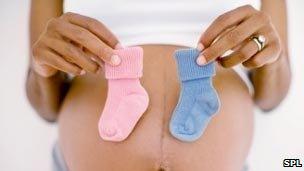IVF 'increases the chance of having a baby boy'
- Published

How you conceive appears to alter the odds
Women using IVF to get pregnant should be aware that they will be more likely to have a boy than a girl, say experts.
Australian researchers found the odds of a boy went up from 51 in 100 when conceived naturally to 56 in 100.
But another assisted reproduction technique called ICSI, which singles out the sperm that will fertilise the IVF egg, makes a girl more likely.
The study reported in the British Journal of Obstetrics and Gynaecology looked at nearly 14,000 births.
This group comprised all live births following fertility treatment in clinics in Australia and New Zealand between 2002 and 2006.
In the UK, over 35,000 women a year undergo IVF.
The University of New South Wales researchers say patients should be counselled about the side effects of different assisted reproduction techniques.
Couples undergoing IVF - where an egg is taken from the woman and mixed with the man's sperm in the lab for fertilisation before being put back into her womb - can expect a slightly increased chance of having a boy, they say.
However, for couples undergoing ICSI - where a single sperm is selected for injection and fertilisation of the IVF egg - the odds lean slightly towards having a girl.
Sex bias
In their study, the likelihood of an IVF birth resulting in a boy was between 53% and 56%, depending on how soon the fertilised egg was put back into the woman.
Taking the higher value, this would mean that in every hundred births, 56 would be baby boys and 44 would be girls.
This compares with 49 boys in every hundred births for ICSI and 51 boys in every hundred births with natural conception.
Editor-in-chief of the BJOG Professor Philip Steer said the balance of boys and girls born in a population - known as the secondary sex ratio (SSR) - varies over time naturally, in response to external factors such as times of hardship with famine or war.
But the latest findings suggest man's interference in reproduction may also be having an impact.
And this could have future implications for public health, says Professor Steer.
"We know that already in some parts of India and China, a higher proportion of male babies have been born or survive because of parents deliberately choosing the gender of their baby, and this is leading to significant social problems with some men being unable to find a wife.
"It is important that we don't allow such imbalances to occur unintentionally, simply because we have neglected to study the factors that influence the secondary sex ratio in the increasing proportion of the population who use assisted reproductive technology."
Fertility expert Dr Allan Pacey, from the University of Sheffield, said: "There is no evidence I am aware of to show that sex ratios at a national level have changed as a consequence of assisted conception procedures, although nature can impose some big variations following natural phenomena and man-made events.
"Patients should certainly not consider using this as a method of trying to have a boy or girl, since the procedure used needs to be selected to try and maximise the chance of pregnancy."